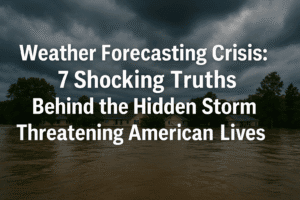Weather Forecasting Crisis: 7 Shocking Truths Behind the Hidden Storm Threatening American Lives
The July 2025 Texas Hill Country flash floods, which killed over 130 people, have reignited concern over deep staffing cuts at the National Weather Service (NWS). Despite issuing timely flood warnings, the NWS is grappling with a 14% workforce reduction, severely impacting local forecasting offices and risking future response capabilities. Experts agree the Texas event wasn’t a forecasting failure, but the extreme weather’s unpredictability exposes a fragile system strained by overwork and unfilled senior roles.
The loss of seasoned staff, reduced weather balloon launches, and burnout are quietly degrading America’s forecasting accuracy. As climate change fuels more frequent and intense disasters, the NWS is becoming critical infrastructure, not a budgetary afterthought. Maintaining “adequate” warnings isn’t enough—lives depend on excellence, precision, and capacity. Ignoring the warning signs of institutional erosion invites future catastrophes. A fully funded, resilient NWS is essential to protecting communities in our new climate reality.

Weather Forecasting Crisis: 7 Shocking Truths Behind the Hidden Storm Threatening American Lives
The Texas Hill Country flash floods of July 2025 were a sudden, brutal tragedy, claiming over 130 lives as raging waters swept through communities. In the aftermath, a critical question emerged, cutting through the political noise: Could staffing cuts at the nation’s weather forecasting agency have played a role?
The Cuts on the Horizon (and Already Here)
While the headlines focused on former President Trump’s proposed 25% cut to NOAA’s $6.1 billion budget slated for Fiscal Year 2026 (starting October 2025), the impact is already being felt. The National Weather Service (NWS), NOAA’s frontline for life-saving forecasts, has quietly bled hundreds of staff:
- 600 Positions Lost: Through voluntary buyouts (200), early retirements (300), and layoffs (100), the NWS has shrunk by roughly 14% of its 4,200-strong workforce since early 2025.
- Local Impact: As of April 2025, nearly 20% of staff were gone from 122 local forecast offices nationwide. These are the experts who know their regions intimately.
Texas: A Tragedy Foretold (But Was the Warning Heard?)
Independent analysis suggests the NWS performed admirably despite these cuts during the Texas crisis:
- Adequate Warnings Issued: The New Braunfels, TX office issued critical “Flood Watch” alerts more than 15 hours before the disaster, specifically naming the hardest-hit Kerr County. Follow-up warnings explicitly mentioned “life-threatening flash flooding.”
- Surge Staffing Worked: The office deployed extra forecasters (5 instead of 2) during the event, mitigating immediate staffing gaps.
- Expert Consensus: Rice University’s Dr. Avantika Gori and meteorologist Chris Vagasky both stated forecasts and warnings functioned normally. The core challenge was the extreme, localized nature of the rainfall – notoriously difficult to predict with pinpoint accuracy hours in advance.
The Real Danger: The Gathering Storm of Depletion
While staffing didn’t cause the Texas forecasting failure, experts sound the alarm about the systemic risk these cuts create:
- Chronic Overwork & Burnout: Remaining NWS staff are stretched thin, often working excessive night and day shifts. Fatigued forecasters are more likely to miss subtle, critical details in complex data – a potentially fatal margin of error during developing severe weather.
- Degraded Data Collection: Staff shortages have already forced a reduction in weather balloon launches across the US. These balloons provide essential upper-atmosphere data crucial for all forecasts, especially modeling the fuel for extreme events like floods and hurricanes. Fewer launches mean lower-quality initial data feeding into models.
- Vacant Expertise: Key positions, like Science Officers and Senior Meteorologists, remain unfilled for extended periods (as noted in Texas days after the floods). These roles provide vital quality control, training, and advanced analysis during high-stress events.
- Erosion of Local Knowledge: Losing experienced forecasters familiar with a region’s unique microclimates and flood risks weakens the precision and context of local warnings.
Climate Change: The Crucial Context
This staffing crisis unfolds against a backdrop of intensifying climate hazards. As Dr. Gori noted, events like the Texas floods are becoming more frequent and severe. Reliable, well-staffed forecasting isn’t just beneficial; it’s increasingly critical infrastructure for community resilience. Cutting resources now is akin to dismantling a lifeboat during rising seas.
The Human Insight: Beyond the Politics
The Texas tragedy forces a stark realization: “Adequate” warnings are the absolute minimum. We should strive for excellence and resilience in our forecasting capabilities. The debate isn’t about assigning blame for one event, but about safeguarding our future preparedness.
- The Overworked Forecaster: Imagine the weight on the remaining NWS staff, knowing lives depend on their vigilance while they juggle unsustainable workloads.
- The Data Gap: Fewer weather balloons mean slightly fuzzier forecasts every day, accumulating risk over time. It’s a slow degradation, not a sudden failure, making it politically easier to ignore – until a disaster strikes where better data might have made a difference.
- The False Choice: Dismissing concerns because warnings “worked this time” ignores the insidious, cumulative damage of understaffing. It’s not about predicting the unpredictable perfectly; it’s about having the resources to maximize accuracy and communication when seconds count.
Conclusion: Weathering the Future
The Texas flash floods were a natural disaster amplified by geography and intense rainfall. The NWS, strained but resilient, delivered the necessary warnings. However, the ongoing exodus of expertise and resources from the agency creates a dangerous vulnerability. Relying on “surge staffing” and overworked personnel is not a sustainable strategy in an era of escalating climate extremes.
Protecting American lives from weather disasters requires more than just functional technology; it demands a fully supported, adequately staffed National Weather Service. The true cost of the current cuts may not be measured in a single missed forecast, but in the gradual erosion of a system designed to keep us all safe. The storm on the horizon isn’t just meteorological – it’s institutional. Ignoring it risks far greater tragedies down the line.
You must be logged in to post a comment.